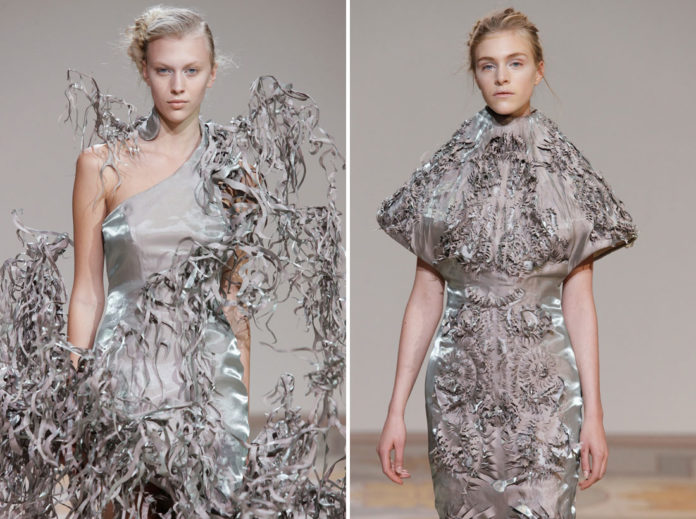
Advantages of volumetric printing are successfully used to make cars, culinary masterpieces, and unique jewelry. It’s useful not only for 3D printing enthusiasts, like top3dshop.com, but also for designers and manufacturers that use additive technologies in their work by creating sportswear and collections for fashion shows.
3D printing possesses a set of significant advantages for the fashion industry. With the help of additive technologies you can:
- create unique and complicated models
- make every product customized (by 3D scanning human body)
- save money on the materials (production with 3D printers is practically waste-free)
Haute Couture fashion
ThreeASFOUR fashion label demonstrated one of the first 3D printed dresses way back in 2003 on a fashion show in New York. It was beautiful but very impractical – you couldn’t even sit in it. But the company continued experimenting: in 2016 it presented a scaly Pangolin dress and soundwave-based Harmonograph dress. You could sit and walk in these clothes, however, the products turned out to be not that pleasant to touch and impractical (quite sticky).
Particularly because of the disadvantages of the materials (it is still hard to synthesize wool and silk identical to natural) designers’ masterpieces so far look more like art objects than regular clothes. However, 3D printed outfits are often worn by celebrities such as Björk and Dita von Teese. 3D printing in the fashion industry on a wider scale is used for producing clothes parts and some accessories. For example, designers Hillary Sampliner, Andrea van Hintum, and Billy Dang made a scaly poncho with a high collar using the laser sintering technology. The piece was printed on a Shapeways printer.
Netherlands-based company Roger Bacon Eyewear uses additive technologies to create fashionable eyewear models. With the help of 3D scanning, individual measurements are taken from customers and the finished product is printed and customized based on those measurements.
Sportswear
Manufacturers of sports accessories, clothing and footwear use additive technologies on a larger scale. For example, famous companies such as Nike and Adidas use 3D printing for producing sneakers. For instance, Vapor Laser Talon by Nike is created with the help of selective laser sintering of powder materials (SLS).
The sole of the Vapor Laser Talon sneakers is made on a 3D printer – it makes the footwear light and provides maximum traction with the surface. And the most important thing is that you can quickly complete an individual order of the client: prototyping allows to make changes to the base model and change its size and shape (and the customer can receive their order in a couple of days).
Their competitor, Adidas, has a series of Futurecraft 4D sneakers, made with the help of 3D printing using polymeric materials (soles are made of resin).
Conclusion
Fashionable clothes, made completely using 3D printing is not yet practical for everyday use but this area of application of additive technologies possesses a high potential. Modern materials allow us to successfully use 3D printing for producing elements of clothing and footwear based on individual measurements.
















